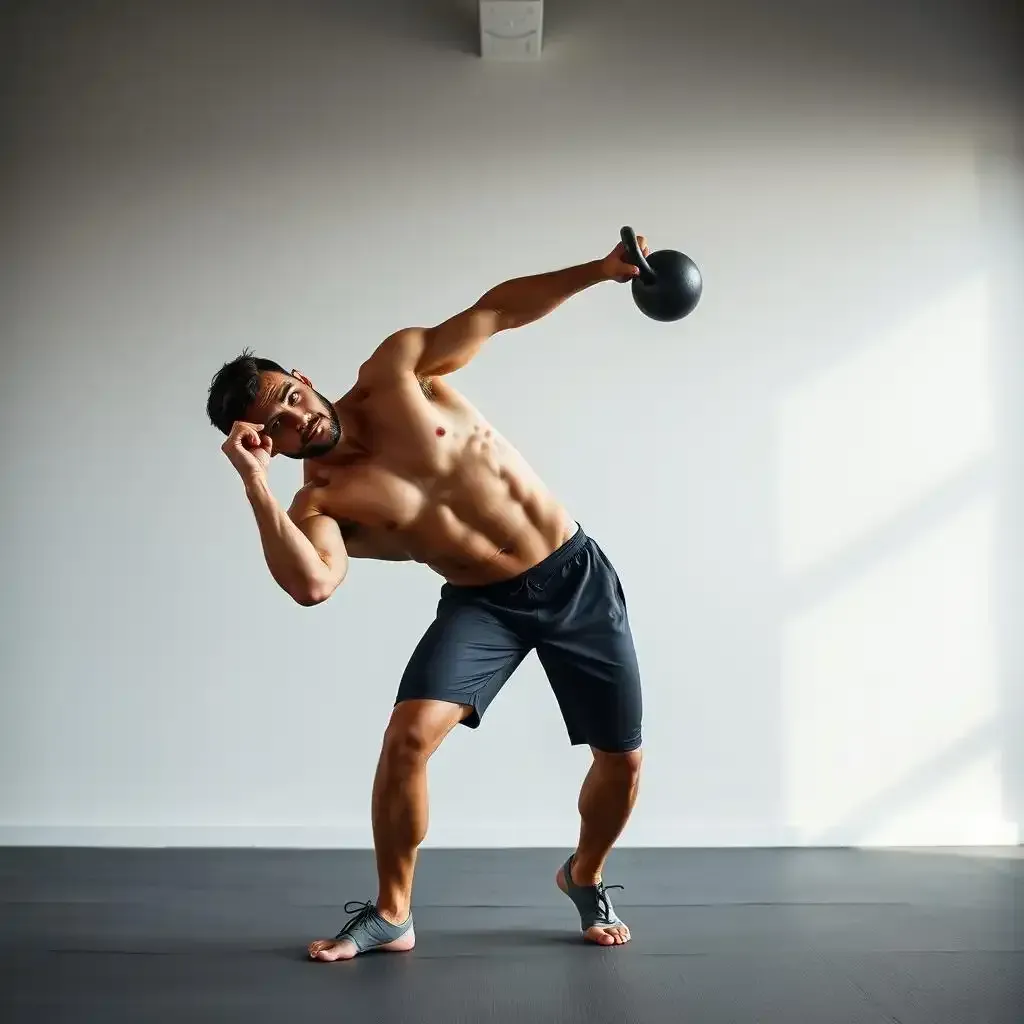Table of Contents
Ever finished a killer kettlebell workout, feeling awesome but also… a little *too* awesome? Like, maybe a bit *too* stiff? That's where cool-down routines come in. They're not just some extra fluff at the end; they're your secret weapon against muscle soreness, injury, and that overall "I'm a rusty robot" feeling. Think of it like this: your muscles are like a high-performance engine. After a serious workout, they need to cool down gradually, not just slam on the brakes. Ignoring your cool-down is like ignoring that nagging engine light – you might get away with it for a while, but eventually, you'll pay the price. This article will guide you through creating effective kettlebell cool-down routines customized to your needs, ensuring you leave each session feeling refreshed and ready for your next kettlebell experience. We'll explore the why, the how, and even some fancy techniques to help you master your post-workout recovery. Remember, consistent cool-down routines are key to your overall fitness trip and long-term success! So, let's examine into it and uncover the ability of a proper cool-down, all here at kettlebellworkout.homes.
Essential Kettlebell CoolDown Routines: Preventing Injuries and Boosting Recovery

Essential Kettlebell Cooldown Routines Preventing Injuries And Boosting Recovery
Why Cool-Downs Matter
Cooling down after a kettlebell workout is like gently easing your car to a stop instead of slamming on the brakes. It helps your body transition from high-intensity activity back to a resting state. Think of it as a mini self-care session that pays off in the long run. By taking the time to cool down, you're not just preventing soreness and stiffness; you're also enhancing your overall recovery and keeping your body in top shape.
If you're new to kettlebell training, check out our . They’ll help you build a solid foundation and make your cool-downs more effective.
Key Stretches for Your Cool-Down Routine
Stretching is a crucial part of your cool-down. It helps relax your muscles, improve flexibility, and reduce the risk of injury. Here are a few key stretches you should include:
- 90/90 Stretch (left/right): This stretch targets your hips and is perfect for releasing tension after a grueling kettlebell session.
- Seated Figure 4 (left/right): Great for your glutes and lower back, this stretch can help alleviate any tightness in those areas.
- 2-way Hamstring Stretch (left/right): Ideal for your hamstrings, this stretch can prevent muscle soreness and improve overall mobility.
- Child's Pose: A relaxing and restorative stretch that gently stretches your back and hips.
For more detailed instructions on these stretches, visit our guide.
The Benefits of a Proper Cool-Down
A well-executed cool-down routine can have a significant impact on your recovery and overall performance. Here are a few benefits to keep in mind:
1. Reduces Muscle Soreness: By gradually lowering your heart rate and stretching, you can minimize the buildup of lactic acid, which is a major contributor to post-workout soreness.
2. Enhances Flexibility: Regular stretching can improve your range of motion, making you more agile and less prone to injury.
3. Boosts Recovery: Cooling down helps your muscles and joints recover faster, so you can get back to your next workout with less fatigue.
4. Supports Long-Term Fitness Goals: Consistency is key in any fitness trip. A proper cool-down routine can help you maintain your workout routine without the downtime caused by injuries or excessive soreness.
If you want to examine deeper into the science behind recovery, check out our guide.
Mastering the Art of Kettlebell CoolDown Routines: Flexibility and Mobility
Okay, so you've just crushed a kettlebell workout. You're feeling amazing, maybe a little sweaty, definitely a bit breathless. But hold on! Don't just collapse on the floor like a deflated bouncy castle. That's where I come in – your friendly neighborhood kettlebell guru – to talk about the importance of cool-down routines. They’re not just some afterthought; they’re the secret sauce to unlocking your kettlebell potential, preventing injury, and making sure you're not stiff as a board the next day.
Think of your muscles as super-powered rubber bands. After a workout, they're stretched tight. A proper cool-down is like gently letting those rubber bands relax back to their normal length. Skip the cool-down, and you risk those rubber bands snapping (ouch!). We don't want that, do we? So let's examine into some cool-down moves that will keep your muscles happy and flexible. Check out our guide to for detailed instructions.
Stretch | Muscle Group | How To |
|---|---|---|
World's Greatest Stretch | Hips, Groin, Back | Start on your hands and knees, then extend one leg back and the opposite arm forward. |
Hamstring Stretch | Hamstrings | Sit with legs extended, reach towards your toes. |
Calf Stretch | Calves | Lean against a wall with one leg straight back and the other bent. |
One of my favorite cool-down stretches is the "child's pose." It's super simple: kneel on the floor, sit back on your heels (as best you can!), and fold forward, resting your forehead on the ground. It's like giving your spine a big hug! It feels amazing after a tough workout, and it helps relieve tension in your back and shoulders. Remember, flexibility isn't just about fancy yoga moves; it's about giving your body what it needs to recover properly and help prevent those pesky injuries.
Another tip? Don't underestimate the strength of deep breathing. After your workout, take some time to just breathe deeply and slowly. This helps to lower your heart rate and calm your nervous system. Think of it as a mini-meditation for your muscles. It's a simple way to help your body transition from "workout mode" to "relaxation mode." For more tips on proper breathing, see our guide on .
- Focus on slow, controlled movements.
- Hold each stretch for at least 30 seconds.
- Listen to your body and don't push yourself too hard.
Remember, a good cool-down routine isn't about pushing your limits; it's about listening to your body and giving it the care it needs. It’s a partnership, not a battle. Consider your cool-down routine as a reward for your hard work – a chance to reflect on your workout, and to prepare your body for the next journey. And hey, who doesn't love a little self-care?
Want to learn more about improving your mobility? Check out our comprehensive guide on . It's packed with tips and tricks to help you enhance your range of motion and feel amazing.
Designing Your Perfect Kettlebell CoolDown Routine: A StepbyStep Guide

Designing Your Perfect Kettlebell Cooldown Routine A Stepbystep Guide
Step 1: Listen to Your Body
Okay, so you've just finished your kettlebell workout. You're probably feeling pretty awesome, maybe a little sweaty, and possibly a bit breathless. But before you collapse into a heap on the floor (don't do that!), take a moment to check in with your body. How are you feeling? Are there any areas that feel particularly tight or sore? This is your chance to become a body detective, figuring out what your muscles need. It's like giving your body a post-workout progress report. This step is super important because it helps you tailor your cool-down to your specific needs. Don't just follow a generic routine; listen to your body's whispers (or shouts!) and adjust accordingly. It's all about personalized recovery.
Remember, everyone's body is different. What works wonders for one person might not be the best for another. Don't be afraid to experiment and find what feels right for *you*. If you're unsure where to start, our guide on offers plenty of ideas.
- Notice any unusual tightness or soreness.
- Identify which muscle groups worked hardest.
- Consider your overall energy level.
Step 2: Create Your Custom Cool-Down
Now that you've done your body scan, it's time to craft your perfect cool-down. A good cool-down typically lasts about 5-10 minutes and involves a combination of light cardio and stretching. Think of it as a gentle transition from high-intensity exercise to total relaxation. For your light cardio, I like slow walking, or even just some gentle arm circles. It's like slowing down a rollercoaster – you don't want to come to a sudden stop!
Next up: stretching! Focus on the muscle groups you worked the hardest. If you smashed your legs with squats, spend some extra time stretching your quads, hamstrings, and calves. If you were doing lots of overhead presses, make sure to stretch your shoulders and triceps. Remember, you can find some amazing stretching tips in our .
Muscle Group | Stretch | Duration |
|---|---|---|
Legs | Hamstring stretch, quad stretch, calf stretch | 30 seconds each |
Back | Cat-cow stretch, child's pose | 45 seconds each |
Shoulders | Arm circles, shoulder blade squeezes | 30 seconds each |
Kettlebell CoolDown Routines: Advanced Techniques for Enhanced Results

Kettlebell Cooldown Routines Advanced Techniques For Enhanced Results
So, you've mastered the basics of kettlebell cool-downs and are ready to take it to the next level. Great! Advanced cool-down routines can help you maximize your recovery, prevent injuries, and keep your muscles feeling fresh. Think of it like giving your body a spa day after a heavy workout. It’s all about pampering those hardworking muscles and making sure they stay in top shape.
One of the most effective advanced techniques is the World's Greatest Stretch. This stretch is like a full-body reset button. Start on your hands and knees, then extend one leg back and the opposite arm forward. This move targets your hips, groin, and back, helping to release any tension you might have built up during your workout. For a more detailed guide, check out our .
Stretch | Muscle Group | How To |
|---|---|---|
World's Greatest Stretch | Hips, Groin, Back | Start on your hands and knees, extend one leg back and the opposite arm forward. |
Leg Swing | Hamstrings, Quads, Hips | Stand with your feet hip-width apart, swing one leg forward and backward. |
Wall Angel | Shoulders, Upper Back | Stand with your back against a wall, arms in a "W" position, slide them up and down the wall. |
Another advanced technique is the Leg Swing. It's a dynamic stretch that can help improve your range of motion and flexibility. Stand with your feet hip-width apart and swing one leg forward and backward. This stretch is great for your hamstrings, quads, and hips. It’s like giving your legs a gentle massage after all that intense work.
Don’t forget about your upper body! The Wall Angel is a fantastic stretch for your shoulders and upper back. Stand with your back against a wall, arms in a "W" position, and slide them up and down the wall. It’s like a mini-shoulder workout but in a cool-down format. For more tips on shoulder health, check out our .
Technique | Target Area | Benefits |
|---|---|---|
Leg Swing | Hamstrings, Quads, Hips | Improves flexibility, reduces muscle tension |
Wall Angel | Shoulders, Upper Back | Enhances shoulder mobility, reduces stiffness |
Deep Breathing | Entire Body | Calms the nervous system, reduces stress |
Final Thought
Remember, a consistent and well-structured kettlebell cool-down routine isn't just about feeling good; it's about protecting your body from injury and maximizing your fitness gains. By incorporating these techniques into your workout regimen, you'll not only prevent soreness and stiffness but also significantly improve your long-term performance. So, take the time to cool down properly – your future self (and your muscles) will thank you for it. Happy lifting!